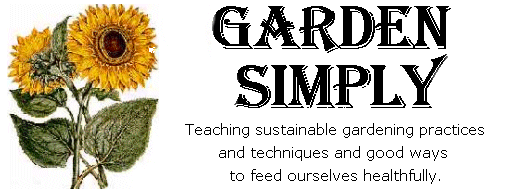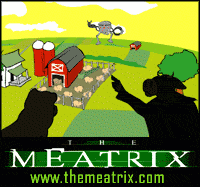Taming the Unruly Garden
How to Keep Your Garden Looking Great All Summer

By Kathy LaLiberte


|
| The flexible edging on my beds has lasted for more than 15 years. |
By the end of the summer, my garden has entered its "tough love" phase. There's a huge bare spot where the Oriental poppies used to be. The globe thistle that I didn't divide last spring has splayed out in all directions. Creeping Charlie is taking over the lavender. It sometimes makes me feel like just staying indoors by the fan.
If you're having a hard time loving your late-summer garden, here are a few ways to rekindle that love:
Set Some Boundaries
There's no way I could have a garden if I didn't use edging and lots of mulch. They reduce my weeding chores by at least 70 percent.
Your garden will be more manageable if you start by clearly defining garden and non-garden space. To do so, you can use any type of permanent edging made of plastic, metal, brick or even stone. Then, in the space designated as garden, use mulch to surround the plants you want and smother the rest. For more about different kinds of mulches, read The Right Mulch Makes a Difference.
It's never too late in the season to mulch, but here's some good news: Putting in edging is a job best left for cooler fall weather. It's a bit of work to install, but once it's in place, the job is done. I've put flexible plastic edging around my vegetable and cutting gardens and most of my flower beds, and it's still working great after 15 years.
Identify Friends and Foes
Unless your gardens were laid out by a landscape designer, you have probably accumulated the same sort of hodge-podge collection of plants as I have. And in that collection there are no doubt a few bad apples that are making a mess of your garden. Those self-sowers and aggressive-spreaders are far more trouble than they're worth, and the sooner you get them out of your garden the better. If you have an area where they can run wild, fine. But these are not plants that play well with others. A few of the thugs I've gradually eliminated from my garden include:
- Helianthus angustifolia (perennial sunflower)
- Macleaya cordata (plume poppy)
- Anemone vitifolia (grape leaf anemone)
- Oenothera speciosa (evening primrose)
- Physostegia virginiana (obedient plant)
- Convallaria majalis (lily-of-the-valley)
- Artemisia ludoviciana (Silver King artemesia)
- Lysimachia clethroides (gooseneck loosestrife)
|
| Daylilies are well-behaved -- and drought-tolerant, too. |
A few of the well-behaved plants that (for me) don't spread, don't need staking, don't have pest problems, and are long lived, include:
- Hemerocallis (daylilies)
- Baptisia australis (false indigo)
- Astilbe
- Dictamnus (gas plant)
- Dorenicum (Leopard's bane)
- Allium senescens
- Coreopsis verticillata (threadleaf coreopsis)
- Salvia superba
- Sedum 'Autumn Joy'
Seating Assignments
I've rarely, if ever, put a plant in the ideal place the first time. Moving plants around is the only way to figure out what works best where. Late summer, when plants are fully mature, is the best time to plan those moves. It gives you the chance to really look at things like height, leaf color, shape and texture, bloom time and flower color.
This planning exercise, best done with a cool drink in hand, is incredibly valuable; even if you only determine two or three plants that clearly need to be moved. Understanding a plant and deciding how to set it off to best effect can't really be learned from a book. The same plant may perform quite differently in your neighbor's garden. Plants shouldn't be moved until the weather cools in fall, so mark the plant with a stake or make a note of it on your to-do list and refill that glass of lemonade.
Fresh Blood
|
| My front entry -- before giving it a fresh, new look. |
Exceptional gardens often have distinctive features such as a wooden pergola, a well-placed sculpture, a set of stone stairs, a distinctive birdhouse or matched pair of cedars. These elements do several things for your garden:
- They serve as organizing principles to plant around, giving your garden beds a sense of place and purpose.
- They draw the eye through the garden (and away from little imperfections).
- They are a unique signature or garden personality that's present every day of the year, whether the peonies are in bloom or there's snow on the ground.
|
| We've almost finished the new front walk, but I'm still looking for the perfect bench, which I plan to place on the left side of the path, near the house. |
Though it's often easy for me to identify features that would enhance someone else's garden, it's much more difficult to do that in my own yard, where I've been gardening for 17 years. I'm too close to see the distinctive features and thematic elements, and know how effectively they work together.
An excellent new book, called Your House, Your Garden, by Gordon Hayward, has really helped me think about how people move through a garden, and how best to play up distinctive features to create impact. After several years of feeling ho-hum about my garden, Mr. Hayward's book finally helped me see that the front walkway presented a terrific opportunity to reframe the entire front garden. Three pallets of stone and five weekends of work later, these changes have had a huge effect on the garden, providing a better sense of order and structure.
Late summer is a time to savor your garden. It's too hot to do much else! So use your eyes to take it all in and come up with a few ideas that can be tackled when cooler weather returns. How's that for a license to relax?
If you have any tips and techniques to share, we'd love to hear from you.
Write to us
Kathy LaLiberte has worked for Gardener's Supply since it began more than
20 years ago. She lives and gardens in Richmond, Vt.
|
|





